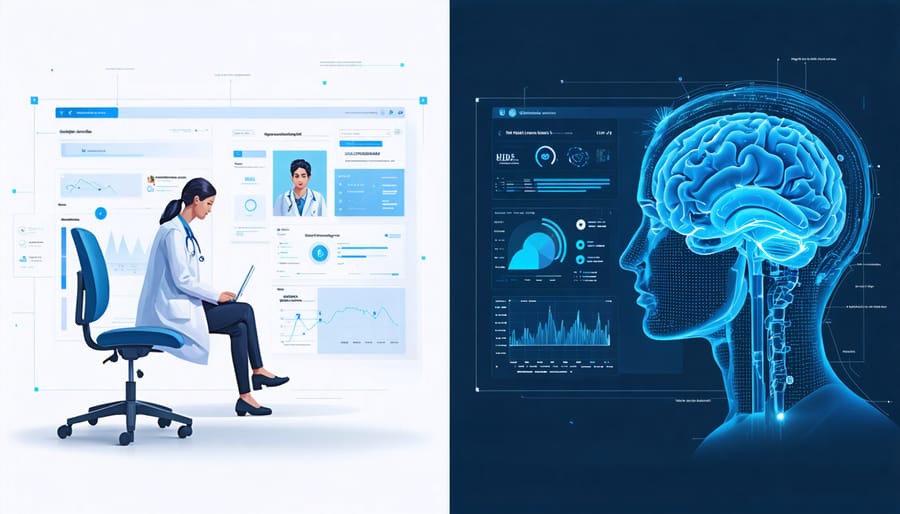The intersection of artificial intelligence and healthcare autonomy stands at a critical legal crossroads in 2024. As AI-driven medical decisions become increasingly prevalent, healthcare providers face unprecedented challenges in balancing patient self-determination with automated clinical protocols. Recent landmark cases, including the 2023 Mayo Clinic AI liability ruling, have highlighted the complex interplay between traditional informed consent doctrines and emerging autonomous healthcare systems.
The legal framework governing medical autonomy must now address three key dimensions: algorithmic transparency in clinical decision-making, liability distribution among healthcare providers and AI developers, and the evolution of patient consent in an AI-augmented medical landscape. With 75% of U.S. hospitals now implementing some form of AI-assisted care protocols, understanding these legal implications has become essential for healthcare professionals, technologists, and patients alike.
This convergence of healthcare autonomy and artificial intelligence raises fundamental questions about medical ethics, patient rights, and professional responsibility. As courts grapple with establishing precedents for AI-related medical decisions, healthcare organizations must navigate a rapidly evolving legal landscape while maintaining their commitment to patient autonomy and quality care. The challenge lies not just in understanding current regulations, but in anticipating how the law will adapt to protect patient rights in an increasingly automated healthcare environment.
This analysis explores the critical legal considerations shaping the future of autonomous healthcare, offering insights into how stakeholders can protect themselves while embracing technological advancement.
The Foundation of Patient Autonomy in Modern Healthcare
Traditional vs. AI-Assisted Medical Decisions
Traditional medical decision-making typically involves direct physician-patient interactions, where doctors rely on their training, experience, and established medical protocols to recommend treatments. Patients then make informed decisions based on these expert opinions and their personal preferences. However, the integration of AI into healthcare is reshaping this dynamic.
AI-assisted medical decisions introduce a new layer of complexity to the traditional process. These systems can analyze vast amounts of patient data, medical literature, and treatment outcomes to suggest diagnostic and treatment options that human practitioners might overlook. For instance, AI algorithms can detect patterns in medical imaging that might escape the human eye or predict potential drug interactions with greater accuracy.
This shift raises important legal questions about accountability and consent. When an AI system influences a medical decision, who bears responsibility if something goes wrong? The physician who followed the AI’s recommendation, the healthcare facility, or the AI system’s developers? Additionally, patients must now be informed about the role of AI in their care decisions, leading to more complex informed consent procedures and potential challenges to patient autonomy.
The key challenge lies in striking a balance between leveraging AI’s capabilities while preserving the human element in healthcare decision-making.

Current Legal Framework for Medical Autonomy
The current legal framework for medical autonomy is primarily built on the foundation of informed consent and patient rights legislation. In the United States, the Patient Self-Determination Act (PSDA) of 1990 requires healthcare providers to inform patients about their rights to make healthcare decisions, including the right to accept or refuse treatment. This law works alongside state-specific regulations that govern advance directives and healthcare proxies.
Key elements of the legal framework include the requirement for healthcare providers to disclose relevant information about treatments, risks, and alternatives. The doctrine of informed consent mandates that patients must receive adequate information to make educated decisions about their care. This includes understanding the nature of their condition, proposed treatments, potential risks, and alternative options.
Recent legislation has also addressed digital health privacy through HIPAA regulations, ensuring patient data confidentiality while maintaining their right to access and control their medical information. These laws establish clear guidelines for protecting patient autonomy in an increasingly digital healthcare environment, while also setting standards for electronic health records management and telehealth services.
AI’s Impact on Healthcare Decision-Making
Algorithmic Bias and Patient Rights
As healthcare systems increasingly rely on artificial intelligence for decision-making, concerns about algorithmic bias in healthcare have become a critical legal and ethical consideration. AI systems trained on historical medical data may inadvertently perpetuate existing disparities in healthcare delivery, potentially discriminating against certain demographic groups.
For instance, algorithms used in patient triage or treatment recommendations might reflect historical biases present in training data, leading to unfair outcomes for minorities, women, or economically disadvantaged patients. This raises significant legal questions about patient rights and healthcare providers’ liability when using AI-driven decision support systems.
To protect patient rights, healthcare organizations must implement robust fairness testing protocols and regular audits of their AI systems. Legal frameworks are evolving to require transparency in algorithmic decision-making and mandate that healthcare providers inform patients when AI systems influence their care decisions.
Patients now have the right to question AI-driven recommendations and seek human oversight of their care decisions. Some jurisdictions have introduced legislation requiring healthcare providers to demonstrate that their AI systems don’t discriminate against protected classes of patients. This includes maintaining documentation of system testing and validation procedures, as well as providing clear explanations of how AI influences patient care decisions.

Data Privacy and Informed Consent
In the era of AI-driven healthcare, managing patient data and obtaining informed consent has become increasingly complex. As healthcare providers integrate sophisticated AI systems into their practices, medical data privacy concerns have taken center stage in legal discussions.
Healthcare organizations must navigate strict regulatory frameworks, including HIPAA in the United States and GDPR in Europe, while implementing AI solutions. These regulations require explicit patient consent for data collection, processing, and sharing, particularly when AI algorithms analyze sensitive medical information.
The concept of informed consent has evolved beyond traditional doctor-patient interactions. Patients now need to understand how AI systems will process their data, what insights these systems might generate, and how these insights could influence their treatment decisions. This includes transparency about AI’s role in diagnosis, treatment recommendations, and potential limitations.
Healthcare providers must implement robust data protection measures, including encryption, access controls, and audit trails. They must also ensure that AI vendors comply with privacy regulations and maintain appropriate data handling practices. Regular privacy impact assessments help identify and address potential risks to patient data security.
Additionally, patients must have the right to access their data, understand how AI systems use it, and request modifications or deletions when appropriate. This empowers patients to maintain control over their medical information while benefiting from AI-enhanced healthcare services.
Legal Liability in AI-Assisted Healthcare
Medical Malpractice in the Age of AI
The intersection of AI and medical decision-making has created new complexities in determining liability when things go wrong. Traditional medical malpractice frameworks, which focus on the standard of care provided by human healthcare providers, must now account for AI systems that assist or make autonomous decisions.
When AI systems contribute to medical errors, determining responsibility becomes particularly challenging. Is it the healthcare provider who relied on the AI’s recommendation, the hospital that implemented the system, or the AI developer who should be held liable? Current legal precedents suggest a shared responsibility model, where multiple parties may bear different degrees of liability based on their roles in the decision-making process.
Healthcare providers must exercise reasonable judgment when using AI tools, maintaining their duty of care to patients while leveraging technological advantages. This includes understanding the AI system’s limitations and being prepared to override its recommendations when professional judgment dictates otherwise. Hospitals implementing AI systems must ensure proper validation, training, and monitoring protocols are in place.
Documentation becomes crucial in these cases. Healthcare providers must maintain detailed records of how AI recommendations influenced their decisions, creating an audit trail that can help determine liability if adverse events occur. As AI systems become more autonomous, legal frameworks will need to evolve to address new scenarios where machine learning algorithms make independent medical decisions.
Healthcare Provider Responsibilities
Healthcare providers implementing AI systems must maintain a delicate balance between leveraging technological advantages and protecting patient autonomy. Their primary responsibility is to ensure informed consent, which means clearly explaining to patients how AI systems are involved in their care, what data is being collected, and how it influences medical decisions.
Medical professionals must verify the accuracy and reliability of AI-powered diagnostic tools and remain accountable for decisions made with AI assistance. They cannot delegate their professional judgment entirely to automated systems. Instead, they should use AI as a supportive tool while maintaining their role as the primary decision-maker in patient care.
Documentation becomes particularly crucial when using AI systems. Providers must maintain detailed records of how AI recommendations influenced their medical decisions and any instances where they chose to deviate from AI-suggested courses of action. This documentation serves both as a legal safeguard and ensures transparency in patient care.
Healthcare providers also have an obligation to stay current with AI technology developments and understand the limitations of the systems they use. This includes regular training on new AI tools, understanding potential biases in AI algorithms, and being prepared to explain these limitations to patients when necessary.
Finally, providers must establish clear protocols for handling AI system errors or malfunctions, ensuring patient safety remains the top priority while maintaining compliance with relevant healthcare regulations and standards.

Future Legal Considerations
Proposed Regulations and Guidelines
Several regulatory bodies are currently developing frameworks to address the growing role of autonomous systems in healthcare. The FDA is proposing new guidelines for AI-enabled medical devices, including requirements for continuous monitoring and regular performance assessments. These regulations aim to ensure patient safety while promoting innovation in healthcare technology.
Industry stakeholders are working on standardization efforts for autonomous healthcare systems, with a focus on transparency and accountability. The proposed standards include mandatory documentation of decision-making processes, clear protocols for human oversight, and regular audits of autonomous systems.
State-level legislation is also emerging, with several states drafting bills to address patient privacy, informed consent, and liability issues specific to autonomous healthcare. These proposed laws emphasize the importance of maintaining patient autonomy while incorporating AI-driven solutions.
International organizations like WHO and ISO are developing global guidelines for the ethical implementation of autonomous healthcare systems, focusing on interoperability standards and cross-border data sharing protocols. These guidelines aim to create a unified approach to regulating healthcare autonomy while respecting different cultural and legal contexts.
Balancing Innovation and Protection
The healthcare industry faces a delicate challenge in balancing innovation with patient protection as AI technologies become more prevalent. To maintain this equilibrium, healthcare providers are implementing multi-layered approaches that prioritize both technological advancement and patient autonomy.
Key strategies include developing transparent AI systems that provide patients with clear explanations of automated decisions, allowing them to make informed choices about their care. Healthcare facilities are also adopting hybrid decision-making models where AI recommendations complement, rather than replace, human judgment.
Organizations are implementing robust consent frameworks that give patients control over how their data is used in AI systems while ensuring they benefit from technological improvements. This includes options for patients to opt in or out of specific AI-driven services while maintaining access to traditional care methods.
Regular audits of AI systems help ensure they remain aligned with patient rights and preferences. Additionally, healthcare providers are creating patient advocacy committees that include both technical experts and patient representatives to oversee the implementation of new AI technologies.
The intersection of autonomous healthcare decision-making and legal frameworks continues to evolve as technology advances. The growing implementation of AI in healthcare presents both opportunities and challenges for patient autonomy, requiring careful consideration of existing laws and the development of new regulations. As we’ve explored, informed consent remains a cornerstone of patient rights, while the integration of AI decision-support systems necessitates updated guidelines to protect both healthcare providers and patients.
Looking ahead, we can expect to see more comprehensive legislation specifically addressing AI in healthcare, particularly regarding liability and responsibility for autonomous system decisions. Healthcare institutions will need to develop robust policies that balance technological innovation with patient rights and safety. The future of healthcare autonomy will likely involve a hybrid approach, where AI augments rather than replaces human decision-making, supported by clear legal frameworks that protect all stakeholders.
Success in this evolving landscape will depend on continued collaboration between legal experts, healthcare professionals, and technology developers to create ethical, efficient, and legally sound autonomous healthcare systems that prioritize patient well-being while managing liability risks effectively.

